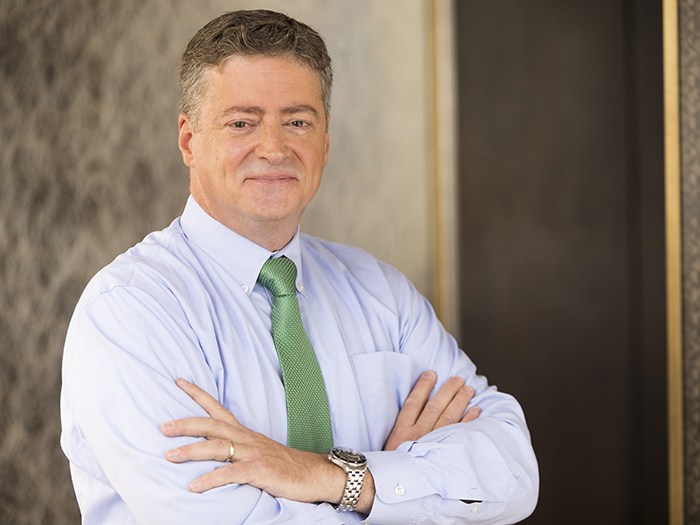11 Questions for Risk Strategies’ CEO John Mina

In October, Risk & Insurance Editor-in-Chief Dan Reynolds met with John Mina, the CEO of Risk Strategies and a veteran of multiple brokerage companies. The goal of the discussion was to learn more about Mina’s vision for the direction of the company, and what he values in his workforce. What follows is a version of that conversation, which was edited for brevity and clarity.
Risk & Insurance: John, you’ve been with the company now for four years. And as we round through 2021 and look ahead to 2022, what business opportunities are you excited about?
John Mina: To start with, we have a really solid history of growth and shareholder value appreciation. That takes a lot of strain out of focusing on fixing things because we’re really focused on the future. Right now we’re the 10th largest privately owned broker and we’re really excited about our potential.
We’re in the middle of our largest growth year ever, both from an organic perspective and from acquisition growth. There’s a lot going on in the market obviously and we don’t want to get too caught up in the frothiness of it all. We are very focused on a specific strategy, and our plan is to continue our growth as we add to our specialty practice expertise and the value that we have to offer for our clients.
I think the current environment presents a lot of opportunities for us and for the industry. We look at risk through the lens of our clients and being a trusted advisor. That means helping them navigate in an extremely challenging insurance market with a worldwide pandemic, changing workforce, the emerging risks that we see, it’s weather events, potentially climate change, all tough things that require specialty expertise.
As I like to say to our team, this is no time to be a generalist. We’re really excited about our specialist approach to risk, which I believe brings increasingly more value to clients. We’re aiming for top five status in each of our major practice areas.
And I should specify, we’re not trying to be good at everything. We’ve got a focus in areas where we want to lead, go really deep technically, understand our client’s businesses almost as well as they understand them before we decide to build something else.
I think there’s a number of growth areas in emerging industries that have interesting risks and challenges, and that would benefit from that specialty expertise driven approach. And I think about them in the tried and true insurance spaces, you have things like management liability. Cyber is obviously very hot right now, and health care is another place where there are challenges
R&I: You touched on some specialty areas you see as interesting. Were there more that you would care to mention?
JM: There are some areas where we’re currently not operating where I would like to grow. We have a really nice position in the cannabis space right now, and we continue to see significant opportunity there, as well as some merging of other specialties.
For example, management liability in the cannabis space is a very challenging area. Then there are spaces where we’re not currently playing. I would say energy, specifically renewables are an area that I think has a lot of promise.
As I like to say to our team, this is no time to be a generalist. We’re really excited about our specialist approach to risk, which I believe brings increasingly more value to clients. We’re aiming for top five status in each of our major practice areas.
I’d also mention infrastructure as it relates to construction. Agriculture is going to present a significant opportunity and also present a fair amount of stress as we look forward over the next five to 10 years. These are all areas that if I was going to invest or acquire, would be on my shopping list.
R&I: In looking at your background, we see a lot of experience in M&A. What do you feel sets your group apart in terms of its expertise in that area?
JM: I think our approach to M&A is a little different than most. There’s so many firms acquiring in the current marketplace. And as my wife likes to say, there’s a lid for every pot.
If you’re selling your business, there is no shortage of destinations to go to. I think what separates us first is the specialty focus.
We don’t have a geographic strategy. We look for businesses that have gone deep within an industry or product. Then we try to provide them with a platform to grow that on a national scale, to benefit their clients and our clients.
So the first criteria would be specialization and the second criteria is culture.
I think what we’re doing is very different than what I would call a pure aggregation roll-up strategy. We’re definitely integrators. We bring those people over to our platform. We utilize the same finance platform, technology, IT, HR, legal but those things aren’t why people got into business to start.
R&I: There’s an interesting dynamic there around shedding the IT and other backend concerns, getting back to what brokers really want to do. Is there a particular size organization that you have your eye on in terms of acquisition?
JM: Well, I think as we’ve grown, we’ve become more comfortable with larger acquisitions. You may pay a little bit more, but I think you generally find teams that have had more depth of experience when you look at larger businesses.
They’ve suffered some potential E&Os or other tough incidents. They’ve survived a couple of different markets. They’ve formed or reformed their business probably a couple of times.
But having said that, I would say we don’t have a set number that we’re targeting. Let’s remember that for us it’s more about what their specialty is. Have they created an interesting or compelling niche that we think we can grow? That’s really our primary focus.
R&I: Generally speaking, what are the key challenges you face as you seek to grow and expand your business?
JM: I would say scaling our growth in business in a thoughtful and effective manner, as we stay intently focused on meeting our clients’ evolving needs: All of that against a backdrop of creating a great environment for our associates to meet their career and personal goals.
I break this down into three categories:
First is staying nimble, being focused and smart on our acquisition strategy and not getting caught up in the rush of a very frothy market.
It’s a competitive market, but we have a strategy and we’re sticking to it. We’re never going to be the top acquirer at any given year. I don’t see it happening. Maybe we’ll make the top ten one day, but that’s not our objective. We’re very much focused on our strategy and sticking to it.
The second thing, I would say, is staying true to our culture.
I believe we’re building something special. Our market advantage is specialization and deep expertise. We want to make sure we aren’t hobbled by typical brokerage operating structures that silo the expertise and then make it difficult for people to access resources that can benefit their clients.
We incorporate positions and processes that enable us to be efficient at scale and building out new specialties and evolve new ones, we’re really working hard to ensure we preserve that flat national structure and our collaborative client- first approach that made us successful.
Mike Christian, our founder, and I talk about this all the time. When it was four people and Mike started the business, they had to be collaborative. Now it’s part of our very DNA and something we talk about all the time.
Third is the changing nature of risk. I would say climate change, pandemic, technology transformation, political and regulatory change, all have placed a lot of weight on the consultative side of our business. Remember that Mike started Risk Strategies as a consultancy and he added the insurance brokerage piece later on.
That consultative approach I view as being really critical. And part of, again, part of our DNA, along with collaboration. So I see the challenge in this environment is building the skillsets and the capabilities around those emerging risks so that we can serve clients’ needs now. And those that they’re likely to have in the future.
R&I: There’s so much talk about the search for talent, how tough it is to get the right talent and tough it is to retain. You’ve got people in their fifties and sixties who are going to be leaving the industry pretty soon. How challenging is that for you and what’s your strategy around that?
JM: First of all, it’s a big challenge for the whole industry. Like many firms, we want to attract and retain the top talent. Our goal is to try and ensure that their work life at Risk Strategies is fulfilling. Part of that comes down to recognizing the changing nature of work for our people and what they’re trying to achieve through it.
We need to provide more support for systems that facilitate knowledge transfer, and that create more transparency between the insurer, the broker, the carrier. If we want to be trusted advisors and to have insurers understood as partners and managing and mitigating risks, technology absolutely can play a role.
Unfortunately, the training programs of yesteryear are largely gone, and now more and more firms are trying to create their own. We’re doing similarly by partnering up younger associates with more seasoned folks to create a natural succession strategy. I think everyone enjoys that.
It’s a little bit more difficult in this remote working environment, but that’s certainly part of our strategy to retain and grow our own talent. I think, though, as an industry, we’re going to be facing a talent shortage for quite some time.
R&I: Can you help us understand how much more robust the training programs used to be?
JM: Absolutely. Thirty years ago, most firms had an in-house training program. The larger ones, AIG, Chubb, Travelers, they certainly all had training programs. There was also a lot of cross flow between brokers and insurers trying to help each other in that area.
In those days, you could send folks to Lloyd’s for a six-week training program or do offsite training. Certainly when I was at Marsh, I went through training, and when I was at Willis, I went through quite a bit. Over time, those programs became fewer and fewer every year.
R&I: What technological developments do you see gaining traction in helping your group to be more productive?
JM: We need to recognize that there is a generational shift going on right now and we’re seeing more digital natives moving into more and more C-suites and making more decisions. The importance of investing in these technologies is critical because we need to be able to meet this emerging generation of business leaders where they live.
As an example, I’m a technology immigrant. I didn’t grow up using an iPad, but today’s generation did. We need to provide more support for systems that facilitate knowledge transfer, and that create more transparency between the insurer, the broker, the carrier.
If we want to be trusted advisors and to have insurers understood as partners and managing and mitigating risks, technology absolutely can play a role.
Here’s just one example. Our surety group partnered with a bond issuing technology to help larger clients quickly self-serve on a classic bond that would otherwise require account people to jump in, adding a whole bunch of lag time. That gives us transparency and efficiency.
Video conferencing technology is another focus area, as today, people are using it more and more for health care visits, as we’ve seen. So the pandemic ended up accelerating some trends that probably would have arrived here 10 years from now. I think the utilization of technology in our industry is only going to continue to accelerate.
R&I: What’s the biggest challenge or difficulty you have in interacting with the carriers around platforms and technology?
JM: There is no universal format for brokers and insurers to exchange data in a standardized fashion. I think that would be helpful if we could create that.
I don’t know whether or not the insurers are going to move to a unified format, because I gather everyone believes that they have their own proprietary underwriting formulas that drive them to success. I think brokers look at that similarly.
One of the things that is frequently missed in the data exchange discussion is that we’re trying to be more efficient, but I don’t know that we’re thinking about how the client views their interaction with us.
As we start thinking about the next decade, the importance of creating almost an Amazon- like experience for clients is going to become increasingly important. Frankly, most technology and Insurtech firms are thinking about how can they exchange data more efficiently with between brokers and themselves. I think we’re forgetting about the client a little too often in this space.
R&I: That’s a great point. You’re shining a light on the more important area, which really is the client experience.
JM: Right. When I think about technology and where we’re investing, our first focus on the investment part was really about how do we ensure the maximum flexibility and safety of our associates?
That was a big part of our technology focus, but I keep asking, “What’s the client’s perspective on all of this? What are they trying to achieve? What would they like to see?”
Let’s allow that to direct our investment strategy. Obviously, no client wants to pay for the inefficiencies of a broker or an insurance company who is sending paper. So that’s a given, but I think the efficiency play is only a small part of it. I think there’s an experience part here that continuously gets overlooked.
R&I: Before we wrap up. I think you mentioned opportunities connected to risks. As an example, you mentioned that climate change is going to impact agriculture. If you look at the key risks you think clients are going to face in the next couple of years, what would you think they would be?
I’d mention three things, cyber being one of them. That’s not going to decrease anytime soon with more and more firms investing in technology.
Second, clearly is our climate. Let’s just call it climate risk. I know climate change can be a political hot topic. My view is that the weather is changing, there’s no doubt about the patterns changing. So things like hurricanes, wildfires, flooding, those aren’t hundred-year issues anymore.
The third one, there’s a sort of a COVID angle, but I think it’s broader than that. I think is employment liability, really is when you think about it from vaccine mandates to changes to family and medical leave, hourly wage regulations for employers, they’ve become increasingly more complex.
And while the market has capacity and appetite, I think getting it right is what counts. And that’s a space that’s continuing to evolve pretty rapidly.
R&I: As you think about your career so far, what experiences have been the most valuable to you?
JM: Two things came to mind there. One was being entrusted to take over the reins as CEO of Risk Strategies from our founder, Mike Christian. That was probably one of the most meaningful experiences of my life. I think you can learn a lot from reading, watching or doing, but doing and being in the seat is by far the most impactful. It’s been an amazing experience so far. I’m incredibly humbled by it.
I think the second experience I would say is, I’ve travelled a good deal over the years, 41 countries and counting and lived overseas for about three years in some interesting places, such as Lebanon and Cyprus, when they were going through some turmoil.
I think that as a result of all that travel, it’s given me a really blunt perspective and the ability to look at business challenges a bit differently. Many times I think those challenges are simply opportunities that need to be reframed.
That’s how I look at the current environment, whether it’s the changing nature of climate risk, or industry and the risks there, or even frankly, the insurance brokers in the market and what’s going on with consolidation, I think we have to reframe some of those challenges as opportunities. &










